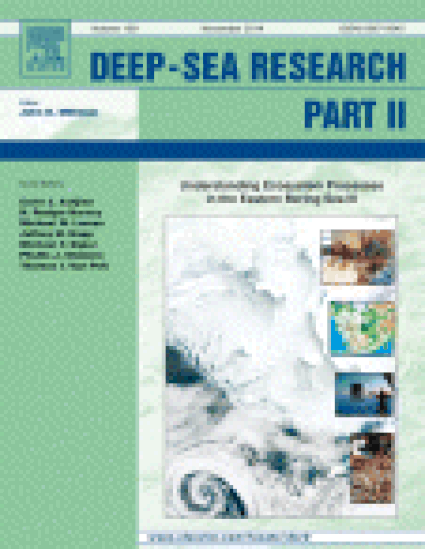
Article
Integrated Assessment of the Carbon Budget in the Southeastern Bering Sea
Deep Sea Research Part II: Topical Studies in Oceanography
(2014)
Abstract
During the primary field program for the Bering Ecosystem Study (2008–2010), independent seasonal estimates of net primary production (NPP), net community production (NCP), vertical export production (Cexp), and benthic carbon consumption (BCC) were used to construct a shelf-wide carbon budget for the southeastern Bering Sea. Here, we quantify the annual production, utilization, and transport of NPP for the southeastern shelf region of the Bering Sea (spatially partitioned into Outer, Middle, and Coastal Domains). We observed that approximately 25% and 30% of NPP on the shelf is exported horizontally from the Middle and Outer Domains, respectively. This horizontal transport was the dominant mode of carbon export in the Outer Domain, exceeding Cexp by more than 30 g C m−2 yr−1 (99 g C m−2 yr−1 compared to 67 g C m−2 yr−1, respectively). In the Middle Domain, Cexp was more prominent than lateral transport (65 g C m−2 yr−1 and 46 g C m−2 yr−1, respectively), and vertically exported carbon was more efficiently recycled in this Domain than in the Outer Domain (53% and 32% of Cexp respectively). In the Coastal Domain, lateral transport was a source of carbon to the bottom layer, with estimated input of carbon exceeding NPP by as much as 54 g C m−2 yr−1. While the source of this additional carbon is unknown, one possible source is transport from the Middle Domain during wind events that induce coastal convergence. Overall, the combined carbon reservoir attributed to burial and transport in the Middle and Outer Domains is similar to a previous budget for this region (47%; Walsh and McRoy, 1986), although some qualitative differences are apparent. The data presented here indicate a more pelagic character in the Outer Domain relative to the Middle Domain, and that the Middle and Coastal Domain carbon budgets are balanced only when combined.
Keywords
- Bering Sea,
- Carbon budget,
- Biogeochemistry,
- Bering Ecosystem Study
Disciplines
Publication Date
November, 2014
Publisher Statement
Copyright © 2014 Elsevier Ltd doi:10.1016/j.dsr2.2014.03.003
Citation Information
David H. Shull, Jessica N. Cross, Jeremy T. Mathis, Michael W. Lomas, et al.. "Integrated Assessment of the Carbon Budget in the Southeastern Bering Sea" Deep Sea Research Part II: Topical Studies in Oceanography Vol. 109 Iss. Understanding Ecosystem Processes in the Eastern Bering Sea III (2014) Available at: http://works.bepress.com/david_shull/3/
